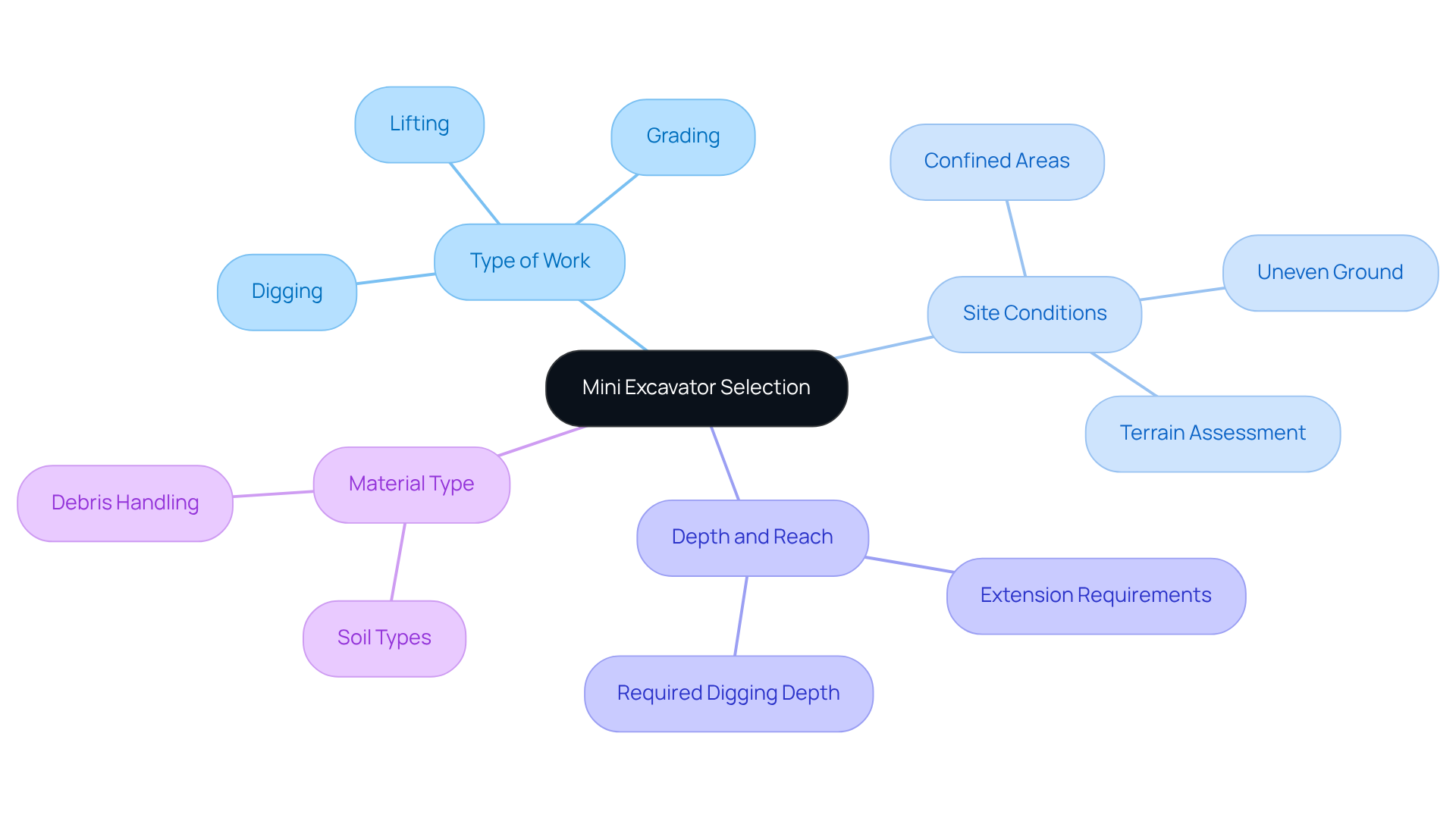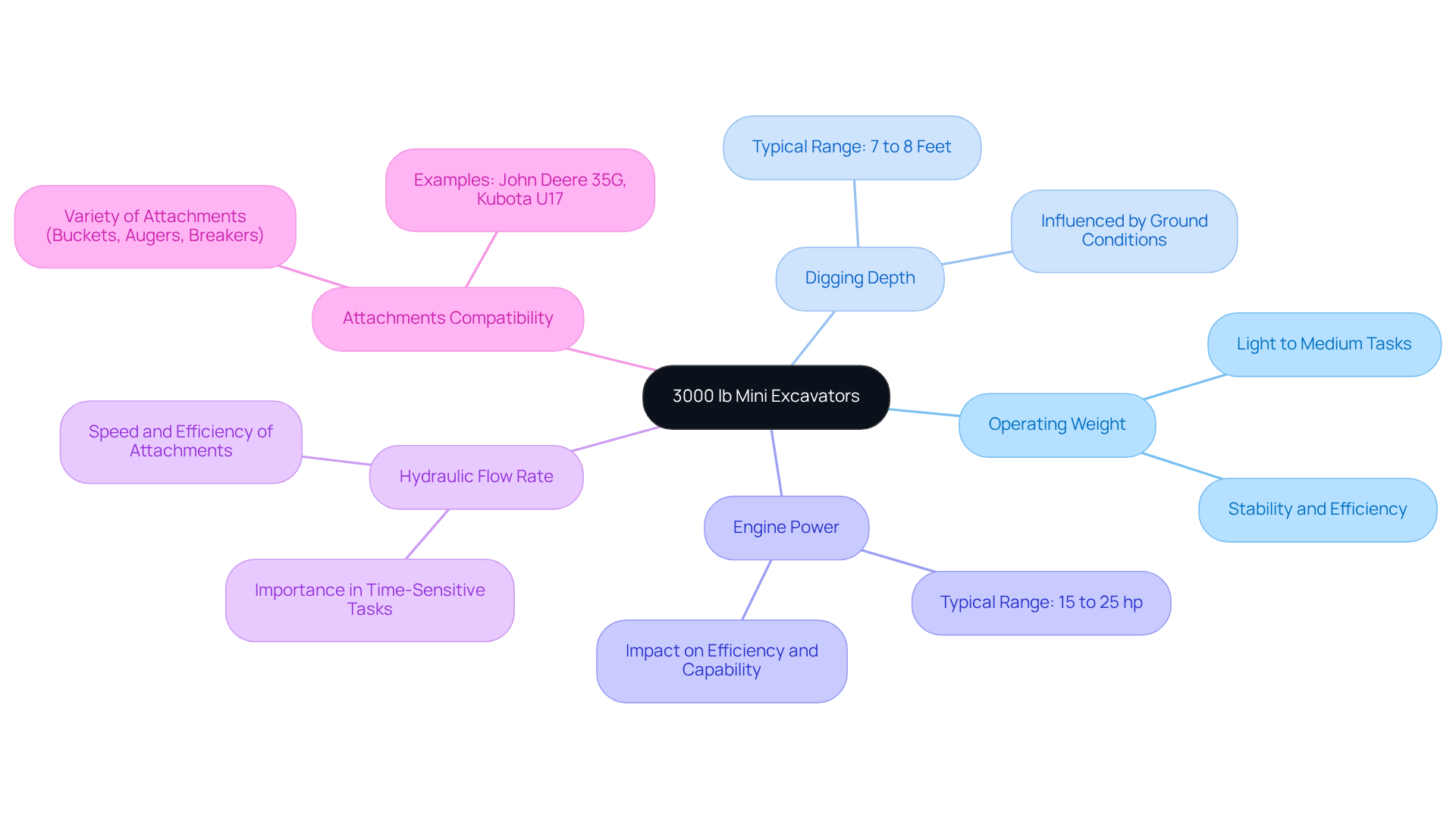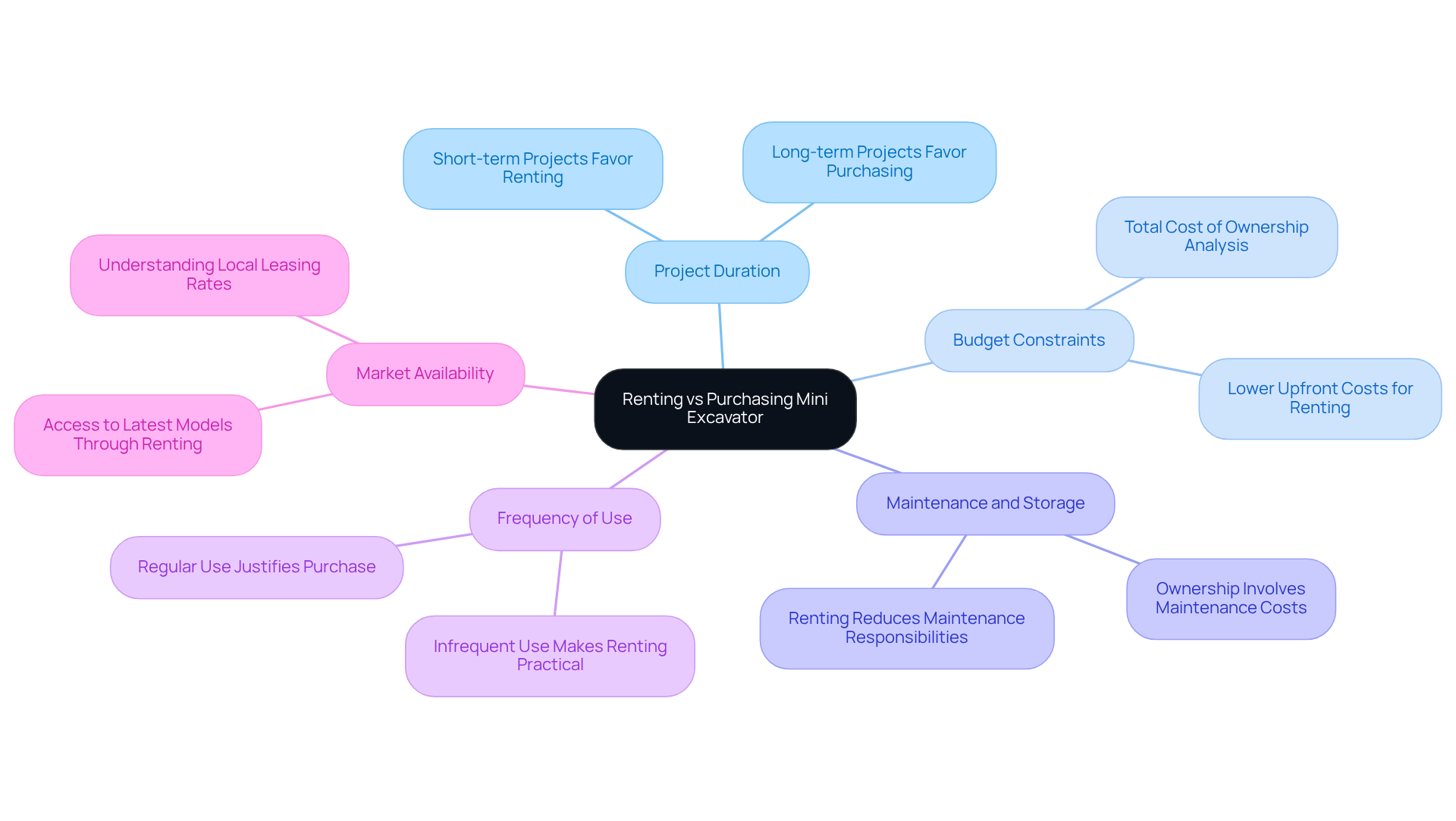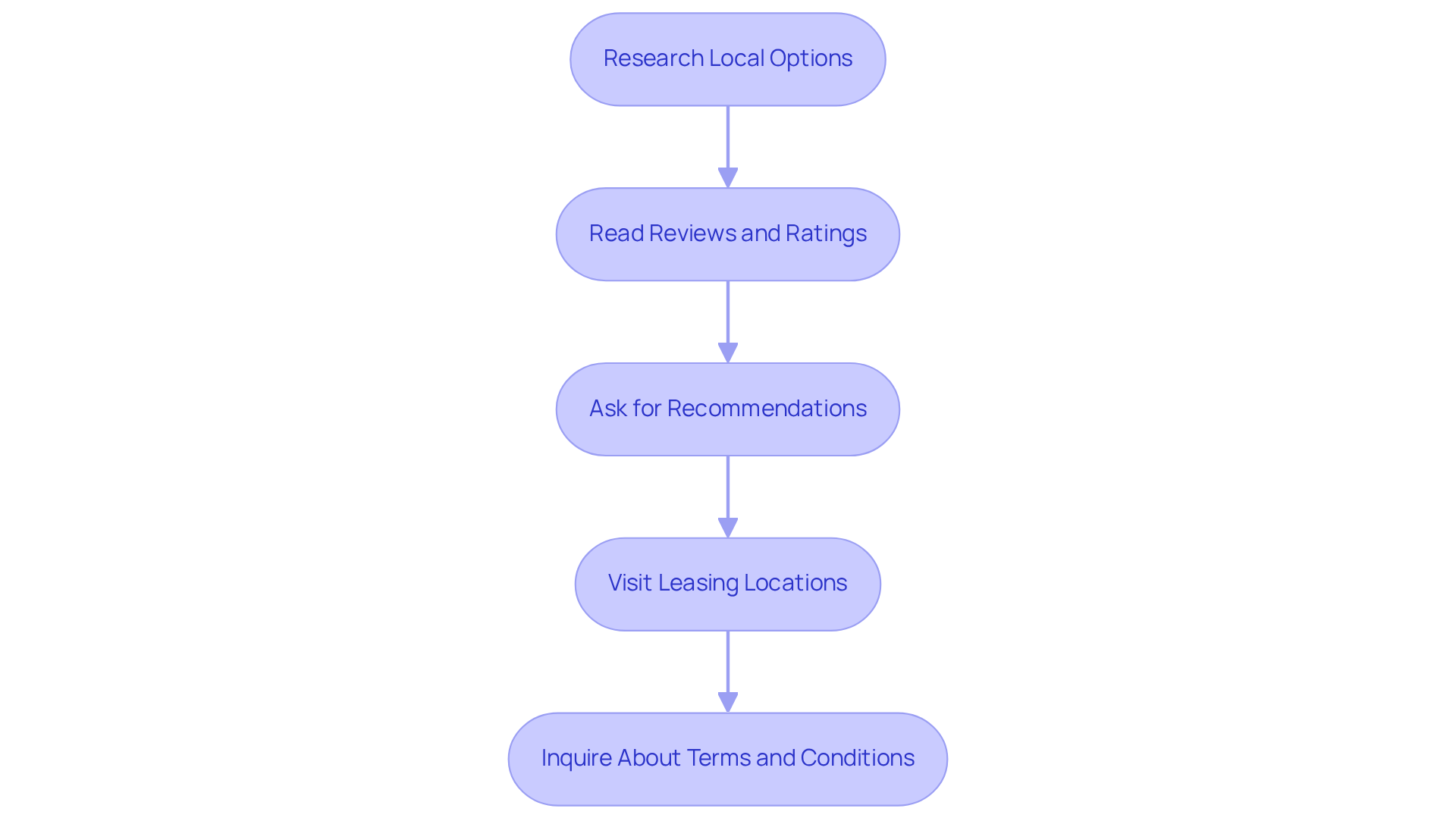Overview
Choosing the right 3000 lb mini excavator demands a clear definition of project requirements, careful evaluation of key specifications, and a thoughtful consideration of whether to rent or purchase based on project duration and budget constraints. It is crucial to assess specific tasks, site conditions, and equipment capabilities to ensure optimal performance.
Furthermore, understanding the nuances of rental services versus ownership responsibilities can significantly influence your decision-making process. By making informed choices, you can enhance project efficiency and effectiveness, ultimately leading to successful outcomes.
Key Highlights:
- Clearly define project requirements, including type of work, site conditions, depth and reach, and material type, when selecting a mini excavator.
- The mini digger market was valued at USD 9.34 billion in 2023 and is projected to reach USD 15.31 billion by 2032, driven by urbanisation and infrastructure developments.
- Key specifications for a 3000 lb mini excavator include operating weight, digging depth (7-8 feet), engine power (15-25 hp), hydraulic flow rate, and attachment compatibility.
- For short-term projects, renting a mini excavator is often more cost-effective, while purchasing may be better for long-term use.
- Consider project duration, budget constraints, maintenance responsibilities, frequency of use, and market availability when deciding to rent or buy.
- To find reputable equipment rental services, research local options, read reviews, ask for recommendations, visit locations, and inquire about terms and conditions.
Introduction
Selecting the right mini excavator is crucial for the success of any construction or landscaping project. Many individuals find themselves overwhelmed by the myriad of options and specifications available. This guide provides a clear, step-by-step approach to selecting the ideal 3000 lb mini excavator, ensuring that all project requirements are met efficiently and effectively.
With numerous factors to consider—such as project type, site conditions, and the decision between renting or purchasing—how can one ensure they make the best choice without overspending or compromising on performance?
Assess Project Requirements for Mini Excavator Use
When selecting a mini digger, it is crucial to clearly define the specific tasks you need it for. Consider the following factors:
- Type of Work: Determine whether your project involves digging, grading, or lifting. Each task may necessitate different attachments or capabilities, which will influence your machinery selection.
- Site Conditions: Assess the terrain and any space limitations. If the digging machine will operate in confined areas or on uneven ground, this will impact your choice of model.
- Depth and Reach: Evaluate how deep you need to dig and how far you need to extend. This information is vital for identifying the appropriate size and type of digging machine.
- Material Type: Take into account the materials you will be handling, as certain machines are specifically designed to manage particular types of soil or debris more effectively.
By clearly defining these requirements, you can significantly narrow down your options and select the most suitable 3000 lb mini excavator for your project. This approach aligns with industry trends, as the mini digger market was valued at USD 9.34 billion in 2023 and is projected to reach USD 15.31 billion by 2032. The market growth is driven by urbanization and infrastructure developments, highlighting the necessity of choosing the right equipment in an expanding market. Furthermore, with the increasing demand for small diggers in the rental sector, understanding these factors becomes even more critical for construction managers.

Evaluate Specifications of 3000 lb Mini Excavators
When evaluating the specifications of a 3000 lb mini excavator, several key factors must be considered to ensure optimal performance for your project.
-
Operating Weight: The excavator's weight is crucial for stability and efficiency. A 3000 lb mini excavator is well-suited for light to medium tasks, providing the necessary balance between maneuverability and power. Comprehending the operating weight is essential for guaranteeing that the machine can meet the requirements of your task, as indicated by equipment experts.
-
Digging Depth: Typically, this weight class offers a maximum digging depth ranging from 7 to 8 feet. It is imperative to verify that this depth aligns with your assignment requirements, particularly for activities such as trenching or utility installation. Ground conditions can significantly influence effective digging depth; harder soils may limit capabilities compared to softer soils.
-
Engine Power: Horsepower ratings play a significant role in the machine's performance. For the 3000 lb mini excavator, a typical range of 15 to 25 hp is observed, impacting both efficiency and capability across various applications.
-
Hydraulic Flow Rate: This specification impacts the speed and efficiency of attachments. An increased hydraulic flow rate allows for faster operation, a crucial element in time-sensitive tasks.
-
Attachments Compatibility: Ensure that the machine can accommodate a variety of attachments, such as buckets, augers, or breakers, tailored to your specific requirements. For example, models like the John Deere 35G and Kubota U17 are renowned for their versatility in attachment compatibility.
By thoroughly reviewing these specifications, you can confidently select a mini digger that meets the demands of your construction or landscaping project.

Decide Between Renting or Purchasing a Mini Excavator
When deciding whether to rent or purchase a 3000 lb mini excavator, several key factors must be taken into account.
-
Project Duration is a critical element. For short-term projects, renting a 3000 lb mini excavator often proves to be the most cost-effective option. Conversely, if the excavator is needed for an extended period, purchasing may yield better long-term value.
-
Budget Constraints also play a significant role. Evaluate your financial situation carefully. Renting typically requires a lower upfront investment, making it easier to manage cash flow. In contrast, purchasing necessitates a substantial initial outlay. Financial advisors frequently recommend analyzing the total cost of ownership versus rental expenses to ensure budgetary alignment, particularly for short-term projects where renting may offer significant savings.
-
Maintenance and Storage responsibilities accompany ownership, potentially adding to overall costs. Renting alleviates these concerns, although it may result in increased costs over time if the equipment is required frequently.
-
Frequency of Use is another important consideration. If you anticipate utilizing the machinery regularly, purchasing may be warranted. However, for infrequent tasks, renting a 3000 lb mini excavator is generally more practical and economical.
-
Lastly, consider Market Availability. Investigate local leasing rates and equipment availability. Renting can provide access to the latest models and advanced technology without the long-term commitment of ownership. For example, average leasing expenses for small diggers in Texas can fluctuate, and understanding these prices can guide your choice.
By carefully assessing these factors, you can make a well-informed decision that aligns with your project requirements and financial considerations.

Locate Reputable Equipment Rental Services
To locate reputable equipment rental services, consider the following steps:
-
Research Local Options: Start by searching online for equipment rental companies in your area, particularly those that specialize in mini excavators and other machinery such as boom lifts and forklifts. Businesses like EZ Equipment Lease in Irving, TX, offer a broad selection of tool leases and sales, catering to the DFW Metroplex. The U.S. machinery leasing market, valued at approximately $47.8 billion in 2021, is projected to expand by $48.6 billion from 2022 to 2029, indicating a robust array of local suppliers.
-
Read Reviews and Ratings: Utilize platforms like Google, Yelp, or specialized construction forums to check customer reviews. Feedback on product quality and client service is crucial, as research shows that 47% of leasing companies are providing more tools to contractors than the previous year, highlighting an increasing focus on customer satisfaction in a competitive market.
-
Ask for Recommendations: Reach out to colleagues or industry contacts for personal recommendations. Insights from individuals with direct experience can guide you toward trustworthy leasing services, especially in a competitive landscape where smaller firms are effectively carving out niches.
-
Visit Leasing Locations: If feasible, visit leasing locations to inspect the equipment and engage with staff. This interaction can provide insight into the professionalism and expertise of the leasing service, which is essential in an industry where quality and reliability are paramount. For example, EZ Equipment Rental in Irving, TX, offers a variety of machinery, including trailers and lifts, ensuring you have access to the right tools for your project.
-
Inquire About Terms and Conditions: Before finalizing a lease, clarify the terms, including pricing, insurance, and maintenance policies. Understanding these conditions is vital, as the typical equipment leasing business allocates around 39% of its yearly income to material expenses, and the average annual income for sole proprietorship equipment leasing enterprises in the U.S. is $168,007. Knowing what you're agreeing to is crucial for a successful leasing experience.
By following these steps, you can identify a reputable rental service that aligns with your project needs, ensuring a successful outcome.

Conclusion
Selecting the appropriate 3000 lb mini excavator is not just a choice; it is a pivotal decision that can greatly influence the efficiency and success of any construction project. By thoroughly understanding the specific requirements of the task, evaluating the machine's specifications, and carefully weighing the options between renting and purchasing, you can make an informed choice that aligns with both project needs and budget constraints.
Key factors such as project requirements, the importance of specifications like operating weight and digging depth, and the decision-making process regarding renting versus buying have been meticulously explored. Each aspect is essential in ensuring that the right equipment is selected, ultimately leading to enhanced productivity and cost-effectiveness.
In a rapidly evolving market that prioritizes urban development and infrastructure, making the right choice in mini excavators is more crucial than ever. Whether through a careful assessment of project needs or by exploring reputable rental services, investing time to understand and apply these insights can lead to successful project outcomes. Empowering yourself with knowledge about selecting the right mini excavator not only facilitates better decision-making but also contributes significantly to the overall efficiency and effectiveness of construction efforts.
Frequently Asked Questions
What factors should be considered when selecting a mini excavator?
When selecting a mini excavator, consider the type of work (digging, grading, or lifting), site conditions (terrain and space limitations), depth and reach requirements, and the type of materials you will be handling.
Why is it important to define project requirements for a mini excavator?
Clearly defining project requirements helps narrow down options and ensures you select the most suitable mini excavator for your specific tasks, leading to more efficient and effective project execution.
How do site conditions affect the choice of a mini excavator?
Site conditions, such as confined areas or uneven ground, can impact the choice of mini excavator model, as different models are designed to handle various terrain types and limitations.
What role does the depth and reach requirement play in selecting a mini excavator?
Evaluating how deep you need to dig and how far you need to extend is vital for identifying the appropriate size and type of mini excavator for your project.
How does the type of material influence the selection of a mini excavator?
Different mini excavators are designed to manage specific types of soil or debris more effectively, so considering the materials you will be handling is crucial in making the right choice.
What is the current market trend for mini excavators?
The mini digger market was valued at USD 9.34 billion in 2023 and is projected to reach USD 15.31 billion by 2032, driven by urbanization and infrastructure developments.
Why is understanding project requirements critical for construction managers?
With the increasing demand for small diggers in the rental sector and the growing mini excavator market, understanding project requirements is essential for construction managers to ensure they select the right equipment for their projects.




